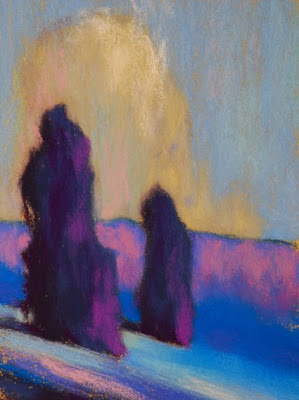
 Trees and Cloud
Trees and Cloud7" x 5"
Pastel
Casey Klahn
Organize your palette.
1. I choose to organize my palette with my pastel sticks peeled and all in a large tray. The tray has ten sections, with violet, red/blue, green/blue, green, intense green, yellow, yellow/brown, red/brown, orange and red. Each section is then organized from dark to light values. I started with mid values in the center and worked outward.
2. Your overstock may need drawers or boxes of their own. I made some wooden boxes for my extra sticks and labeled them by their color.
3. As mentioned in tip #1, organize your color palette by intensity. I have a separate tray for intense ultramarines, and a dedicated section in my big tray for intense, or high key, greens.
4. Some choose to keep their precious brand in the original boxes. This can be a mistake, in my opinion. Think about whether this gimps up your ability to freely move from one color, or brand, to the next when making color choices. The advanced artist learns to kill the precious thing. It is an impediment to keeping momentum in a painting, and in reaching the overall purpose of a work.

5. I keep an eye on my tinted grays versus pure grays. The pure grays are in a box separate from my big palette.











2 comments:
kill the precious thing sounds about right: i quite quickly did that with the pastels, but i think it also applies much more generally in painting: what i've found in a fair number of compositions was that i had to kill the thing that intrigued me to start with. lol. well: usually painting no3 or 4 on the composition allowed me to put it back in. but i think it's been one of the most useful (and frustrating) things to learn about painting.
I notice that with the New School Color pastels I have to move quickly. Unlike with a very realistic LS, which can be left on the easel for later. There just is a difference in the outcome.
Thanks for commenting, Gesa.
Post a Comment